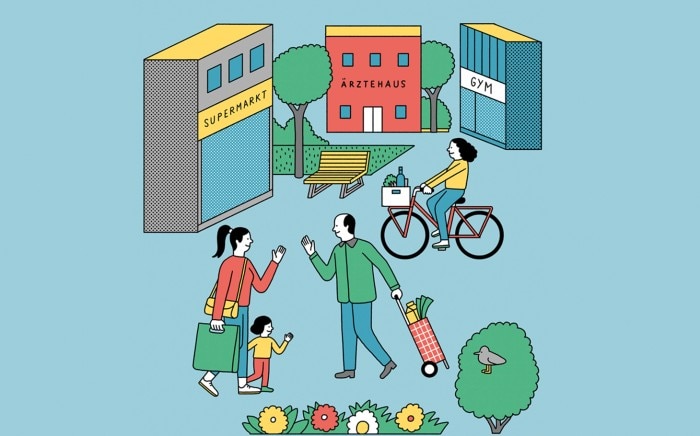Está a punto de abandonar este sitio.
Por favor, tenga en cuenta que su carro de la compra actual no ha sido guardado todavía y no podrá ser restablecido en el nuevo sitio ni cuando regrese. Si desea guardar su carro de la compra, inicie sesión en su cuenta.

A City for People
Exploración de las ciencias de la vida
- Off the Bench
- Ciencia inspiradora
Short distances, fewer cars – this is the basic idea of the 15-minute city. Everything important should be accessible fast – on foot or by bike. City planner Marcel Cardinali from Bielefeld, Germany, knows what this concept should look like in practice.
Climate: Parks, Not Parking Lots
Most cities are characterized by car traffic. The consequences: an immense need for space and high emissions. The 15-minute city, on the other hand, is constructed in such a way that as many destinations as possible may be reached within 15 minutes, either on foot or by bike. This includes shopping and sports activities, work or a visit to the doctor. Destinations outside this radius are conveniently connected via public transit. As a result, as residents are less dependent on cars, a large proportion of mobility-linked emissions are eliminated. An additional bonus: ground thus far sealed will be repurposed in a climate-friendly manner. Parking lots could be parks, and traffic lanes could become pedestrian precincts lush with vegetation.
Society: Rediscovering Conversation
A city designed for cars sepa- rates people from one another. Motorized individual traffic reduces opportunities for exchange between societal groups. The chance encounters that are so typical for a park or the bus will not happen if one sits alone in the car. The 15-minute city offers opportunities for once again allowing conversation between different people and social backgrounds – simply through their physical presence of being in the same place at the same time. Even people’s identification with their own place of residence, as well as their sense of community, could be enhanced in this way.
Health: More Exercise Throughout the Day
The World Health Organization estimates that by 2030, 500 million people worldwide will suffer from illness as a result of inactivity. More sports activities would help, for sure. But covering our daily distances not in the car, but on foot or on bike, has a great effect. The 15-minute city provides its inhabitants with incentive to move more. Shops supplying daily needs are within walking distance; green spaces and car-free zones invite one to stroll with friends and family. One positive side effect: spending valuable time together enhances psychological wellbeing. It is certainly a lot better than being stuck in traffic – an unfortunate reality for many in today’s big cities.
Economy: More Flexible Work
Over the past years, the world of work has undergone substantial changes that are summarized by the buzzword “New Work”. The amount of co-working space has risen, and, due to the COVID pandemic, working from home has become commonplace. A proportion of workers can now carry out their work entirely digitally; commuting by car is a thing of the past for them. This is how the 15-minute city works perfectly with the idea of more flexible work. People who work in their neighborhoods spend more time there, even during the day, than they would if they were to commute to the office, thus generating the required customer base for shops, cafés and pharmacies. Leer más
Leer menos
THE CITY SCIENTIST
Marcel Cardinali is a city planner and researcher; he teaches at the OWL University of Applied Sciences and Arts (Germany), and he is a member of the board of directors at the Institute for Design Strategies (IDS). Marcel Cardinali also works on the Horizon 2020 research project URBiNAT, leading a team of researchers who study the “impact of nature-based solutions on health and wellbeing”.
MarcelCardinali_473x700_540.jpg)
“Developing Individual Solutions on a Neighborhood Level”
Why are so many cities geared strongly towards cars?
Marcel Cardinali: The cities of Europe have grown historically over centuries. The core contains the city center, with dense structures originating in medieval times that had been built for walking-distance travel. Industrialization introduced factories, which were built surrounding the city center. The proximity of these industrial plants to living quarters led to such extreme health problems that in 1933, based on the Athens Charter, a “sorted city” arose – in particular, the separation of working and living areas. After the Second World War, it became possible to live in modern housing units away from the rubble, with plenty of green space right outside one’s door. Longer distances were among the consequences, making a large proportion of society dependent on cars.
How can such cities transform into 15-minute cities without cars?
The cities of Europe have already been built – although they are subject to continuous transformation. Such changes always affect existing structures. The “New Leipzig Charter on Sustainable European Cities”, adopted in 2007, thus speaks of multi-level cooperation and a localized approach. For these reasons, it must be possible to develop individual solutions on a neighborhood-level while including all stakeholders involved. Due to climate change, a heightened level of awareness of this topic already exists among governments and residents. After all, in this country, motorized road traffic is responsible for roughly 15 percent of CO2 emissions.
And what if new neighborhoods are planned and built?
Helpful perspectives for the planning of new neighborhoods include the human scale and the needs of future residents. We are talking about daily urban systems. If the daily life of all residents can be well reflected within the neighborhood, and if their lines of movement cross paths in a single place with public transit, much has been gained. Commercial units, day care centers, schools and co-working areas ensure vibrancy throughout the day. A walking distance of 15 minutes provides a rough guideline for the maximum expansion of the neighborhood.
Leer más
Leer menos

